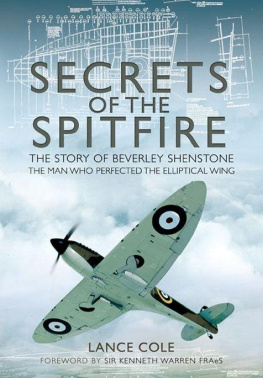STORM RISING
A Movie Treatment
The true story international aeronautical design and espionage between the great wars, focusing on Beverley Shenstone, developer of the Spitfires elliptical wing.
By Vernon Brooks

Agio Publishing House
Agio Publishing House
151 Howe Street, Victoria BC Canada V8V 4K5
2015, Vernon Brooks. All rights reserved.
Without limiting the rights under copyright reserved above, no part of this publication may be reproduced, stored in or introduced into a retrieval system, or transmitted, in any form or by any means (electronic, mechanical, photocopying, recording or otherwise), without the prior written permission of both the copyright owner and the publisher of this book.
Email: bruce.batchelor@gmail.com
www.stormrising-movie.com
Front cover [HU1664] and back cover [CH27] photos courtesy of the Imperial War Museum. Other images bigstockphoto.com. Photo of the author by Janet Brooks.
Storm Rising
ISBN 978-1-927755-19-8 (paperback)
ISBN 978-1-927755-20-4 (ebook)
Cataloguing information available from and Archives Canada.
Agio Publishing House is a socially responsible company, measuring success on a triple-bottom-line basis.
Table of Contents
Dedication & Authors Notes
This story is dedicated to the memory of Beverley Shenstone whom we knew as the cousin of my late wife Nancy Fraser. His life story is so incredible that I want it made into a movie so people can be inspired by his example.
We thank the Toronto Reference Library for permission to quote items from Beverley Shenstones unpublished autobiography held by the Library.
Storm Rising is a work of creative non-fiction written by Vernon Brooks about real people and events. A few dates have been changed in the accompanying scripts and unknowable espionage details created to advance the story line. All events are real or could have been, although Germanys Secret Police Chief Heinrich Himmler and his associate Reinhard Heydrich assumed their posts in 1931 instead of 1929 as described.
Logline
In the style of box office blockbuster The Imitation Game, Storm Rising reveals the true story of espionage and aeronautical design that led to the Spitfire fighter plane being superior to the German fighters, helping win the Battle of Britain. A nerdy young Canadian (Beverley Shenstone) unwittingly becomes the key figure in a battle of wits between British MI6 and the Nazi secret police as both countries race to re-arm prior to the rising storm of World War II.
Synopsis
SYNOPSIS Version One
In the style of box office blockbuster The Imitation Game, Storm Rising reveals the true story of espionage and aeronautical design that led up to the Spitfire fighter plane being superior to the German fighters, helping win the Battle of Britain and thwarting Hitlers massive invasion plans.
In 1929, unaware of MI6s behind-the-scenes help, nerdy young Canadian engineering graduate Beverley Bev Shenstone obtains a key foreign student worker position at the Junkers aircraft factory in Dessau, Germany where he gathers critical information on aircraft design and construction techniques, and on clandestine Nazi rearmament plans. His activities are monitored by the charming Hedda Mller (actually a Nazi police spy).
Narrowly avoiding attack by the brutal Nazi Brownshirts militia, Shenstone moves to the Wasserkuppe glider school where he works for the brilliant designer Alexander Lippisch. When the SS attempt to kidnap him, Shenstone is rescued by British air attach and spymaster G/C Malcolm Christie, and ingeniously smuggled out of the country.
A position awaits him at Supermarine Aviation Works, helping chief designer R.J. Mitchell by designing an innovative elliptical-shaped wing for the new Spitfire fighter. In the lead-up to war, Shenstone makes secret trips into Germany to observe their prototype jet fighters.
With better maneuverability and speed compared to the German Messerschmitt Bf109, Spitfire pilots help win the aerial Battle of Britain. Without air superiority, Hitler cannot invade Britain. Shenstones espionage and aeronautical prowess have made an important and largely unknown contribution to victory.
SYNOPSIS ALTERNATE Version
Its 1929 and the Great Depression has begun. With the stock market crash, German businesses fail, the US government cancels its aid to Germany and unemployment soars. As dissent builds, Hitlers National Socialist German Workers Party (Nazi party) is ominously growing in influence and membership. Although forbidden to create warplanes by the 1918 Treaty of Versailles, Germany boosts top aeronautical designers and manufacturers such as Dornier, Fokker, Junkers and Messerschmitt who are creating world-leading military and civilian aircraft.
Meanwhile, in Toronto, Canada, a bright young aeronautics engineering graduate, Beverley Bev Shenstone, is fixated on learning how planes can be designed with metal skins instead of wood and canvas, with single wings instead of as biplanes. In 1929 he lands a trainee spot in the Junkers aircraft factory with the help of his Toronto professor and unseen British Intelligence connections. The nave Bev has no insight into German politics, which makes him a person of interest to both the German and British Secret Services, the former to pursue for interrogation and the latter to protect and cultivate as an unwitting industrial spy.
Bev becomes fluent in German and greatly expands his aeronautics knowledge, in part though internship with brilliant designer Alexander Lippisch, soaking up German methods of aircraft design and manufacture. He also learns to understand Nazi fanaticism and brownshirt street brutality. His stay becomes precarious.
In 1931, after narrowly avoiding being kidnapped by Nazi security agents, Bev is extricated spectacularly by British MI6 to work at the Vickers Supermarine works in Southampton, England.
In 1933, Hitler becomes German Chancellor and unites his country in preparation for the storm of World War (WWII) that will devastate Europe in 1939/40.
Drawing on his German training and own brilliance, in 1934 and 1935 Bev designs and refines a thin elliptical wing for the Supermarine Spitfire fighter prototype. This enables both high speeds and very tight turns which will help RAF pilots best the German Me 109e fighters in aerial dogfights and win the Battle of Britain in 1940. As a consequence of this defeat, Germany is forced to cancel its planned invasion of Britain. Thus preserved, Britain can rebuild and serves as the launching point for the massive Allied invasion of Western Europe in 1944. Germany surrenders in 1945.
Right up to the declaration of war in 1939, Bev makes discrete visits into Germany to meet with top aeronautical designers at their factories, gathering vital intelligence about German aircraft capabilities for the British Air Ministry. During the war, he works in Britain and visits the USA, liaising with the US military and aircraft industry. After the war, he helps Alexander Lippisch who has been extracted from a crumbling Germany at wars end in Operation Paperclip secure work on jet-powered delta wing designs.
The movie could begin and end with a Canadian family in Toronto, today, discovering the young Canadian Bev Shenstones pivotal contribution to WWII victory through his unpublished memoir and files of clippings, photos and drawings.
Draft: Act-by-Act Treatment











